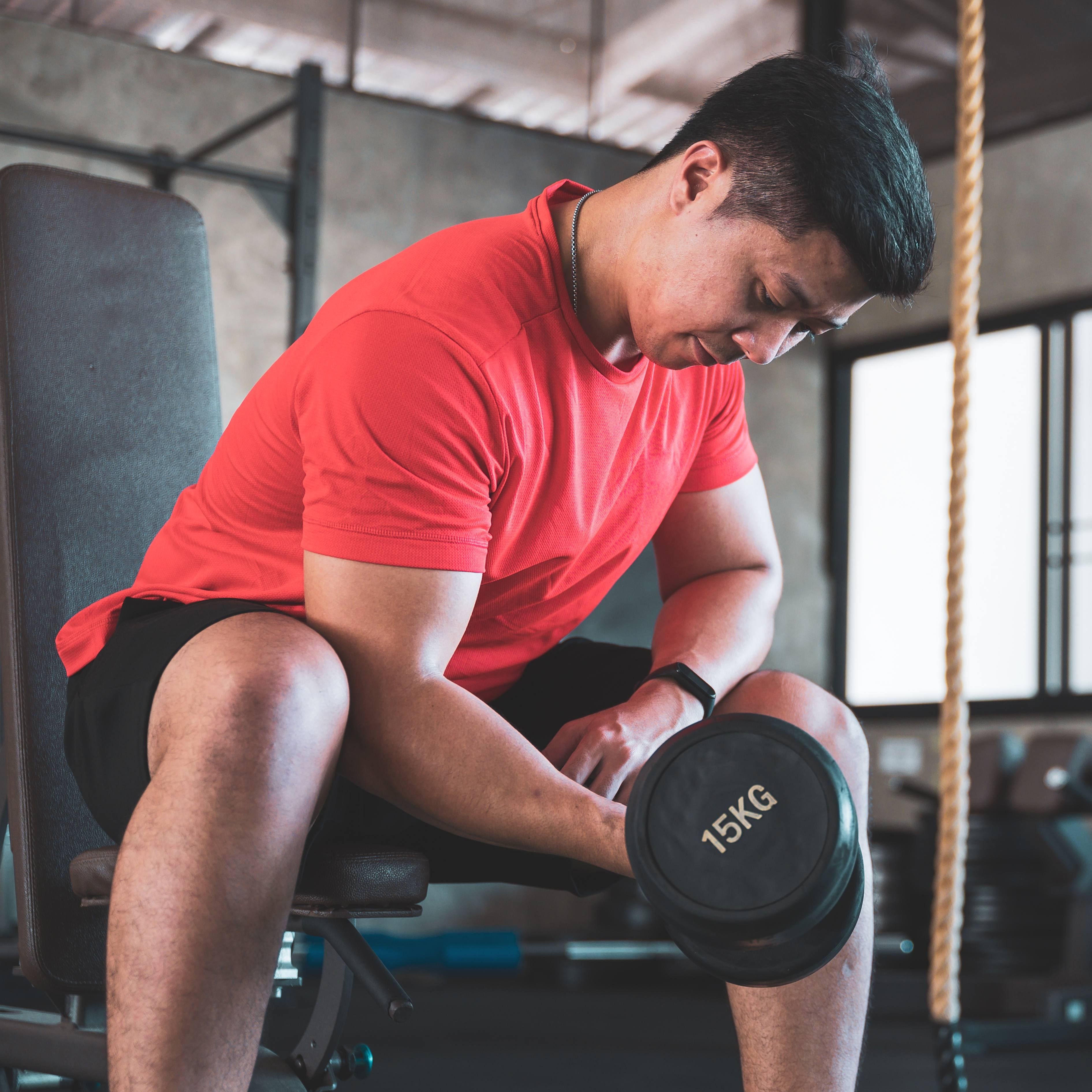-
Advances in sports medicine emerging from Mayo Clinic Health System and collaborators
The year 2020 offered more research challenges than normal. Many researchers shifted their focus almost entirely to SARS-CoV-2 and COVID-19 – looking for ways to detect, treat and prevent infection, while some projects were forced to take a backseat until conditions improved. Others found the time they needed to move their non COVID-related studies along, publishing papers that added to the understanding of a wide range of health and wellness concerns.
Andrew Jagim, Ph.D. (@AJagim), exercise physiologist, and director of research, Sports Medicine, Mayo Clinic Health System in Southwest Wisconsin, is one Mayo investigator who did just that, publishing 17 different studies in 2020. However, every publication was a team effort, he says, with each study born out of a shared focus of helping people improve their athletic performance, or of finding ways to treat and prevent injuries and other chronic problems.
"Our research program is highly collaborative," says Dr. Jagim. "We are fortunate to have an extensive network of external collaborators across multiple institutions."
"Our collaboration with the University of Wisconsin – La Crosse is a cornerstone of this network," says Dr. Jagim, "particularly in lieu of the recent signing of our Research Agreement between Mayo Clinic Health System and the University. This official collaboration has provided valuable opportunities to work with faculty members across each site and get students engaged with the research process."
This collaboration led to several publications made possible through the leadership of certified athletic trainer Joel Luedke (@joel_luedke), UW-La Crosse's assistant athletic director for Athletic Training and Sports Performance.
One was conducted because of COVID-19, with immediate and future ramifications, Dr. Jagim says. "We sought to assess the changes in training habits and perceptions of athletes, as the COVID shutdowns occurred. We found there were notable reductions in training frequency, as well as time spent completing strength and sport-specific training, in part due to limited access to home training equipment."
This is noteworthy, he says, because as conditioning levels fall, so does injury resilience and peak performance. To facilitate a safe return to sport after an extended period of isolation or disrupted training due to the pandemic, he and his colleagues recommend strength training staff develop contingency plans and return to training guidelines. These plans should include in-home training options with easy-to-implement modalities requiring minimal and portable equipment.
Dr. Jagim was the first author on this paper. Other institutions' experts also contributed, including senior author Clayton Camic, Ph.D., associate professor, Exercise Physiology, College of Education, Northern Illinois University.
Another paper with immediate practice implications included some of the same experts, along with senior author Margaret Jones, Ph.D. (@dr_mtjones8), professor, School of Sport Recreation and Tourism Management, George Mason University, Fairfax, Virginia. Dr. Jones is also director of the Patriot Performance Laboratory in the Frank Pettrone Center for Sports Performance.
"We looked at the relationship between preseason training load and measures of next-day recovery in collegiate American football players," says Dr. Jagim.
He and his colleagues found that perceptions of training intensity can predict next-day levels of neuromuscular fatigue. "Furthermore, perceptions of recovery status – whether a player felt he was recovered sufficiently – were directly correlated to the preceding day's workload," says Dr. Jagim.
"This is important, because both physical and mental exhaustion play a role in player resiliency, and the ability to maintain or increase training intensity in progressing days. This can provide value to smaller athletic programs who may not be able to afford the cost-prohibitive technology as the subjective measures of workload appear to be a good indicator of player readiness and training demands," he says.

Jacob Erickson, D.O., led another study, examining the changes in metabolism, body composition and athletic performance that occur between the second and third operations for a 3-step procedure needed by some patients with ulcerative colitis (a type of inflammatory bowel disease, or IBD). Dr. Erickson is a sports medicine physician based in Onalaska, Wisconsin, with Dr. Jagim, and collaborators from Texas Tech University, Lubbock, Texas and Lindenwood University, St. Charles, Missouri also involved with the study.
The researchers followed the outcomes of a very physically fit, 33-year-old Caucasian male throughout his recovery process. The project was supported by Chad Kerksick, Ph.D. (@chadkerksick), associate professor, Exercise Science, and Richie Stecker (@richiestecker), the Exercise & Performance Nutrition Lab coordinator, at Lindenwood University School of Health Sciences. They collected baseline data a few days before the second surgery, and at three intervals (4, 8 and 16 weeks) following a specialized colorectal procedure referred to as a J-pouch surgery.
While recovering from the surgery, the patient experienced a reduced ability to exercise, and reported drastic dietary changes due to decreased appetite as well as commencing recommended dietary restrictions. When the investigators collected 4-week data, they found considerable reductions in total and lean body mass, resting metabolic rate and aerobic capacity.
The patient was eventually able to add light strength training into his daily routine, and by the 8-week point, had restored daily physical activity levels to near baseline. However, the team found he still had reduced aerobic capacity, even at the 16-week mark.
"We believe this case study is valuable as it was the first time these questions have been examined in such a physically fit patient," says Dr. Erickson. "Our findings give us information to help patients meet the challenges of living with inflammatory bowel disease, regardless of the level of intervention required at the time."
"People typically are in their mid-to-late 30s when they are diagnosed with IBD," says Dr. Erickson, "and have several decades of a challenging health situation ahead of them."
"If we can help patients develop and maintain a high fitness level, this can mitigate some of the deleterious effects of the disease, and improve their quality of life," he says.
"Furthermore, if our patients are physically fit and active but still need to undergo these surgical procedures, what we learned in this study can help us guide them through recovery to better outcomes than otherwise might have been expected," Dr. Erickson continues.
The investigators also note in the paper that future research may benefit from the preliminary findings of the study.
In another collaboration with a doctoral student at Texas Tech – Patrick Harty (@PSullivanHarty), formerly a graduate student at Lindenwood University, and Dr. Kerksick, the Mayo team examined the differences in the frequency and severity of federally reported adverse events between 2014-2018 regarding caffeine-containing and non–caffeine-containing products such as those used for energy, weight loss, or in a pre-workout supplement.
A total of 23,269 adverse events were reported in the researchers' categories of interest over that time. Of these, 90% were reports associated with non-caffeinated products. The group then stratified the adverse events based on severity of health outcomes, which included: emergency department visit, disability or hospitalization, life-threatening, or death.
"Interestingly, we found there was a higher relative frequency for the two most severe categories of adverse events (death and life-threatening) associated with exposure to caffeine-containing products. The adverse events associated with products marketed as ‘energy enhancing’ and ‘weight loss’ represented the highest percentage of adverse events from the caffeine-containing subgroups,” explains Dr. Jagim.
The researchers also found that adverse events involving pre-workout supplements had five times the odds of resulting in a more severe adverse event than the non-caffeinated group. Furthermore, weight loss products had higher odds of being associated with life-threatening situations or resulting in death than non-caffeinated products.
"Many of the more problematic products contain multiple ingredients that are purported to increase energy, metabolic activity, and alertness while reducing sensations of fatigue or hunger," says Dr. Jagim. "Unfortunately, few of them have rigorous medical research behind them, either as individual ingredients, or when combined in some sort of drink/energy shot or dietary supplement."
"Moreover, using multiple supplements, or exceeding indicated serving size, may lead to poly supplementation issues," he says. "In addition to potentially ingesting dangerous levels of caffeine, other complications may arise if consuming mega doses of certain ingredients, particularly when exact dosages are not disclosed."
He says these are findings that health care providers may want to address with their patients. Additionally, medical providers should be made more aware of this post-market surveillance program to help centralize supplement-related adverse events to bring more awareness to the issue.
These studies and the others published in 2020 with various collaborators contribute to the Sports Medicine Department's overall mission to provide evidence-based care to patients, says Dr. Jagim. It also creates unique opportunities to work with other research groups and individuals. “One of the most exciting aspects of collaborating with external research groups is the ability to involve more students in the research process. Several of the collaborative publications in 2020, were student-led projects, culminating in a first-author publication for them, which is a great opportunity for a graduate student,” explains Dr. Jagim.
"We strive to be at the forefront of scientific innovation for sports medicine, health and performance focused research," he says. "We aim to not only be a leading research force in this area but also to bridge the gap between research and its practical application by serving as an education platform and shaping our clinical practice."
Our primary research focus is on the use of different nutritional and training strategies to improve measures of performance and health. Through our research and education efforts, we aim to also serve the community and surrounding region by offering clinical services and resources for those wanting to improve their health, wellness, and performance.
###
Editor's Note: All photos were taken before the implementation of social distancing and masking requirements of COVID-19.
Related Articles









